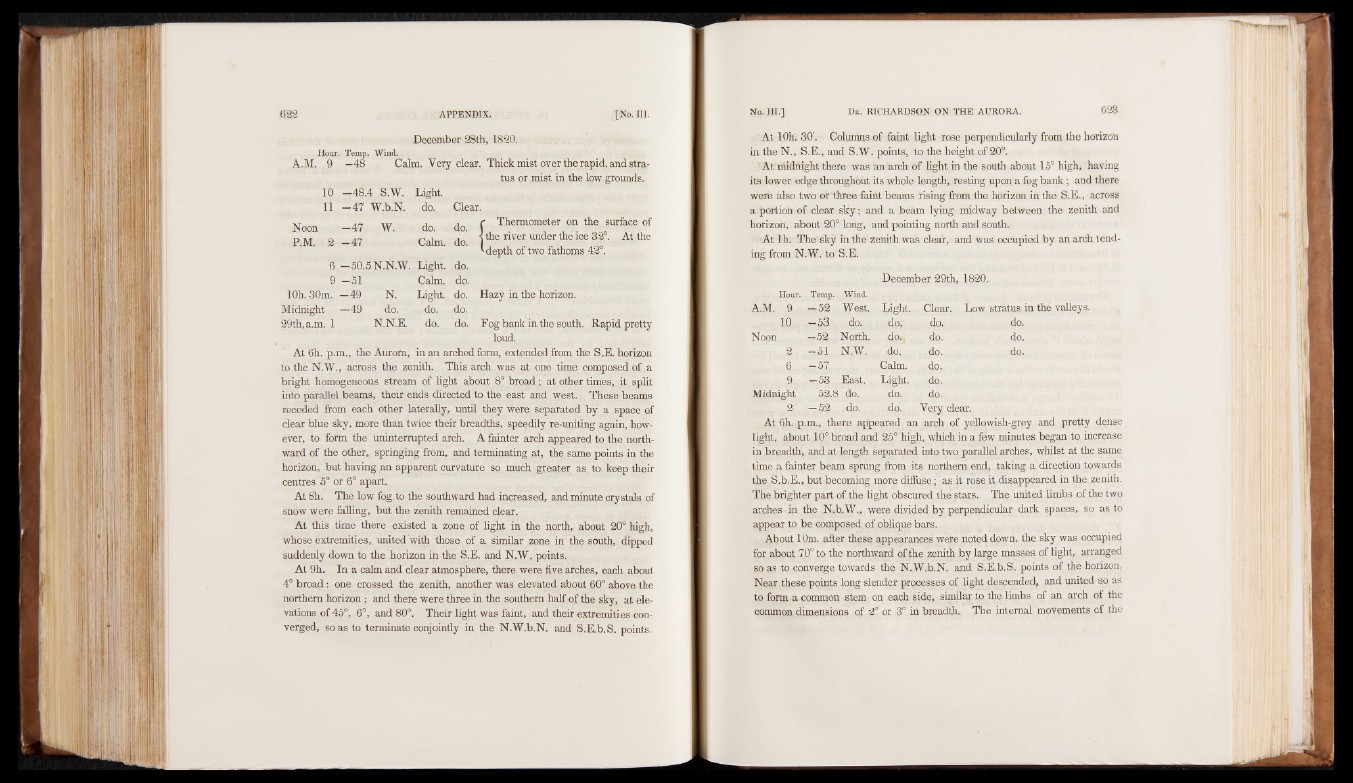
December 28th, 1820.
Hour. Temp. Wind. A.M. 9 —48 Calm. Very clear. Thick mist over the rapid, and stratus
or mist in the low grounds.
10 -48.4 .S.W. Light.
11 -4 7 W.b.N. do. Clear.
Noon -4 7 W. do. do. r Thermometer on the surface of
P.M. 2 -4 7 Calm. do. j the river under the ice 32°. At the
^ depth of two fathoms 42°.
6. —50.5N.N.W. Light. do.
9 -51 Calm. do.
10h. 30m. —49 N. Light. do. Hazy in the horizon.
Midnight -4 9 do. , do. do.
29 th, a.m. 1 N.N.E. do. do. Fog bank in the south. Rapid pretty
loud.
At 6h. p.m., the Aurora, in an arched form, extended from the S.E. horizon
to the N.W., across the zenith. This arch was at one time composed of a
bright homogeneous stream of light about 8° broad; at other times, it split
into parallel beams, their ends directed to the east and west.. These beams
receded from each other laterally, until they were separated by a space of
clear blue sky, more than twice their breadths, speedily re-uniting again, however,
to form the uninterrupted arch. A fainter arch appeared to the northward
of the other, springing from, and terminating at, the same points in the
horizon, but having ,an apparent curvature so much greater as to keep their
centres 5° or 6° apart.
At 8h. The low fog to the southward had increased, and minute crystals of
snow were falling, but the zenith remained clear.
At this time there existed a zone of light in the north, about 20° high,
whose extremities, united with those of a similar zone in the south, dipped
suddenly down to the horizon in the S.E. and N.W. points...
At 9h. In a calm and clear atmosphere, there were five arches, each about
4° broad: one crossed the zenith, another was elevated about 60° above the
northern horizon; and there were three in the southern half of the sky, at elevations
of 45°, 6°, and 80°. Their light was faint, and their extremities converged,
so as to terminate conjointly in the N.W.b.N. and S.E.b.S. points.
At lOh. 30'. Columns of faint light rose perpendicularly from the horizon
in the N., S.E., and S.W. points, to the height of 20°,
1 At midnight there was an arch Of light in the south about 15° high, having
its lower edge throughout its whole length, resting upon a fog bank; and there
were also two of "three faint beams rising from the horizon in the S.E., across
a portion of clear sky; and a beam lying midway between the zenith and
horizon, about 20° long, and pointing north and south.
At Ih: The sky in the zenith wa's clear, and was occupied by an arch tending
from N.W. to S.E.
December 29th, 1820.
: Hour. Temp. Wind. A.M. 9 ,-5 2 West. Light. Clear. Low stratus i
10 -5 3 do. do. do. do.
Noon -5 2 ’North. dohj do. do.
-51 N.W. do. do. do.
\ . — 57 Calm. do.
9 -53. East. Light. . do.
Midnight $2.8 do. dp. do.
.. 2 -5 2 do. do. Very clear.
At 6h. p.m., there appeared an arch of yellowish-grey and pretty dense
light, about 10° broad and 25° high, which in a few minutes began to increase
in breadth, and at length separated into two parallel arches, whilst at the same
time a fainter beam sprung from its northern,end, taking a direction towards
the S.b.E., but becoming more difluse; as it rose it disappeared in the zenith.
The brighter part of the light obscured the stars. The united limbs of the two
arches in the N.b.W., were divided by perpendicular dark spaces, so as to
appear to be-composed of oblique bars.
About 10m. after these appearances were noted down, the sky was occupied
for about 70° to the northward of the zenith by large masses of light, arranged
so as to converge towards the N.W.b.N. and S.E.b.S. points of the horizon.
Near these points long slender processes of fight descended, and united so as
to form a common stem on each side, similar to the limbs of an arch of the
common dimensions of 2° or 3° in breadth. The internal movements of the